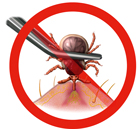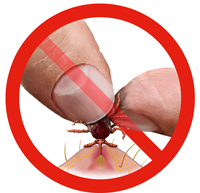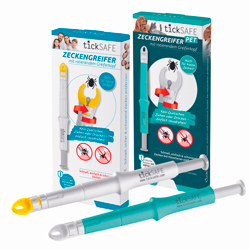The seven rules of tick removal
- Avoid imprudent panic reactions! Don´t scratch, pull or rub the tick off!
- Remove the tick as soon as possible, as the longer a tick feeds the higher the risk of infectious transmission.
- Avoid squeezing or crushing the tick during removal. If no Tickgripper is available, lift out the tick with cannula (should be done by a specialist).
- Disinfect the bite wound. Warning! Disinfection is not sufficient to hinder infectious disease transmission!
- Observe tick bite. A very quick developing redness around the tick bite usually is caused by a local body's reaction to the foreign protein of the tick. An erythema migrans (a variable rash or reddening of the skin due to Lyme disease) normally occurs a few days to weeks or even longer after the tick bite.
- Consult your physician should pain, swelling, rash or other signs of infection or illness develop.
- Save the removed tick for sending in if necessary.
Never squeeze or crush a tick during removal!

Such can cause a tick to "regurgitate" stomach contents which may be infectious and transmit disease.







